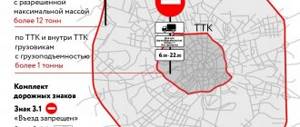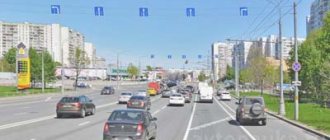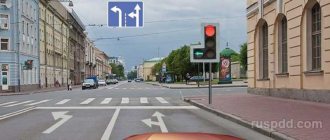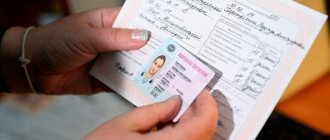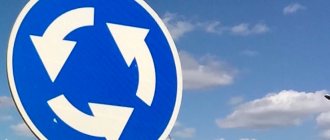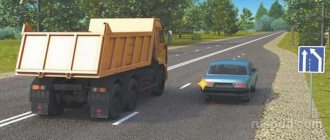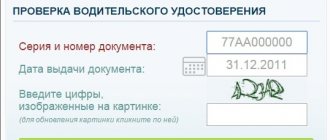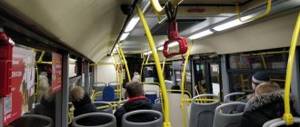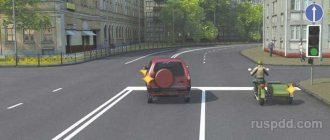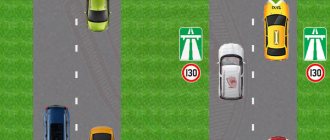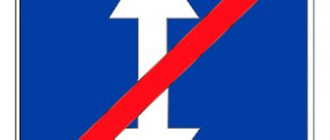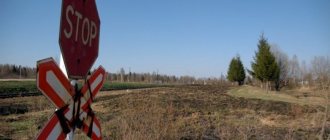Start of movement, maneuvering
The beginning of movement is the beginning of beginnings.
This topic in the exam papers covers more than three questions in one paper.
The first rule - before the first trip on the road, a novice driver must confidently master all the controls of the car -
to press the brake or gas pedal in time.
Know that it is necessary to turn on the direction indicators in advance when performing a maneuver, and turn them off immediately after its completion.
When entering the road from adjacent areas, give way to everyone who crosses your path.
Turning is carried out only from the leftmost lane; exceptions may only be for long road trains or narrow roadways.
Read more here
.
General provisions
First of all, it is enough to know that in Russia there is right-hand traffic and you can only move on the extreme right side of the road, and use your eye to determine the width of the roadway. The first step is to divide the road
in half and know your lane for traffic; the lane width according to GOST should be from 2.5 to 4 meters. The right of way for traffic is given to those who have their own lane free or are on the main road.
Read more here
Travel speed
Next, you need to be able to maintain the speed of your car corresponding to the speed of traffic on the road, and when moving slowly, not interfere with other road users, for which you can also get a fine. To join the flow you must be ready for it.
If you are afraid and cannot move at the set speed, or for any other reason, simply turn on the hazard lights, look in the rearview mirror and gradually begin to move to the right, and stop on the side of the road, or as far to the right as possible to the edge of the roadway, put up a warning triangle at a distance of at least 15 meters behind your car. If you are on a turn, the distance from your car to the sign must be at least 30 meters.
Permissible speed according to the Rules:
- In residential and courtyard areas no more than 20 km/h
- On roads in populated areas no more than 60 km/h
- Outside the populated area no more than 90 km/h ( there are restrictions for various vehicles)
- On the Motorway no more than 110 km/h and no less than 40 km/h (there are restrictions for various vehicles)
More details here
About traffic rules
People constantly violate traffic rules (traffic rules) due to ignorance or for some other reason. This article will tell you about the rules of the road : why traffic rules are needed, why you need to know and follow them.
Traffic rules are a set of rules governing the responsibilities of vehicle drivers and pedestrians, as well as the technical requirements for vehicles to ensure road safety.
Every day you are a participant in traffic, a pedestrian, a driver or even a cyclist, so it is extremely important .
Traffic regulations is a thin book (only 40-odd pages), which contains many years of experience related to road traffic. Not a single item is listed there just like that. Behind each is a large number of traffic accidents and deaths. And it’s not at all difficult to read (or better yet, learn) these rules in order to save your life. They taught more at school, but almost nothing was useful. And the traffic rules will definitely come in handy.
Somehow I came across an article whose title said that following traffic rules cannot always save the driver. Interesting, of course. But the content amazed me. For example, it said that you shouldn’t drive around puddles, otherwise you might get into an accident, and you shouldn’t drive along the side of the road, otherwise you might hit a dog. Dear, in the traffic rules there is not a word about the need to avoid puddles, and there is a fine for driving on the side of the road. But people will read the headline and believe that the rules do not need to be followed. Although the content of this title contradicts. Read the traffic rules and don’t be fooled!
Why follow traffic rules? I don't understand why they should be violated . Do you like to pay fines so that your hard-earned funds go to someone unknown? Or maybe you don't feel sorry for your car? Do you like to beat him, then pay for the repairs again with your own money? Or are you tired of living? Or maybe you want to go to prison (you never know, anything can happen)? Of course, I understand that people are always in a hurry, so they exceed the speed limit and cross the road in the wrong place. But are you really ready to lose your life because of important matters? Unclear. Following traffic rules will save your life and save money .
You need to know the rules of the road completely . If you are a pedestrian and do not intend to purchase a car in the near future, you should still know the rules regarding vehicles. If you are a driver, you need to know the rules about bicycles and motorcycles. Everything is important! If you get into an accident, you must indicate that the other person violated. Suppose a car and a moped collide. The collision resulted in the death of the moped driver. The driver of the car does not know about the rules regarding the moped, so he cannot protect himself. He will be jailed unless he proves that the moped driver violated traffic rules. Or maybe the moped was not driving in the far right lane, maybe without a helmet. And these are completely different circumstances. You’re probably thinking now: “If an accident happens, then I’ll read the rules and point out what the other person violated.” It won’t work, you won’t have time for it. In case of an accident, inspectors arrive and record the accident. If you don’t immediately indicate that the moped driver was not wearing a helmet, then you certainly won’t prove anything later.
In conclusion, I would like to present a video that very clearly shows the importance of traffic rules:
Every accident could have been avoided if all the characters in the video had followed the traffic rules. Everyone! And this is no joke. You can imagine how many people would survive...
Traffic rules are very important . Our site will help you deal with them and tell you what to do in a given situation. Good luck on the roads!
Overtaking, oncoming traffic
Overtaking is considered to be the advance of one or more vehicles into the oncoming lane .
Advancing traffic within the carriageway of the same direction is not considered overtaking.
Before overtaking, the driver must be 100% sure that the maneuver is safe. This requires both experience and cold calculation. It’s better not to take risks if the speed is already more than 80 km/h and you have less than 5 years of experience.
Read more here
What is traffic rules and where is it used?
Every year there are more and more cars on the streets of our cities. Their movement requires orderliness and compliance with certain rules to ensure the safety of drivers and pedestrians.
For this purpose, in every country, including Russia, a special set of traffic rules has been developed that regulates the rights and responsibilities of all people on the roads. What is traffic rules? Where are they used and what are the consequences of violating them?
What does traffic rules mean? Why are traffic rules needed? What is a traffic violation? What is a lawn, according to Russian traffic regulations? What are the consequences of violating traffic rules? Why are they deprived of their rights under the new traffic rules?
What does traffic rules mean?
Traffic rules are traffic rules and technical requirements that apply to vehicles while driving. The first to attempt to introduce them on city streets was the Roman commander Julius Caesar.
Back in the 50s BC, he ordered all owners of carts and chariots to move only on one side and not to go on the roads after sunset. During the Middle Ages in Europe, knights were allowed to drive on the right, which is still in effect in most countries of the world today.
The modern history of traffic rules begins in London in 1868, when a mechanical semaphore appeared in front of the British Parliament. Since then, the rules for traveling on roads have been constantly expanding and adding new requirements due to the growing number of vehicles.
Why are traffic rules needed?
The main purpose of traffic rules is to protect motorists and pedestrians from road accidents that result in damage to vehicles, injury or death.
Every driver should know them, because if he breaks the rules and gets into an accident, then at best he will get off with a fine and expenses for vehicle repairs, and at worst he will die or go to prison for causing injury to other participants in the accident. For this reason, knowledge of traffic rules is a prerequisite for obtaining a driver's license.
What is a traffic violation?
The most dangerous traffic violations are considered to be driving while intoxicated, with a faulty brake system, lighting equipment or steering wheel controls, as well as speeding and driving against a red light. They threaten that the driver may lose control and have an accident. Violating the rules for using seat belts, overtaking, or crossing railroad crossings that are closed by a barrier poses no less of a threat.
Less dangerous, but fraught with unpleasant consequences, are driving unregistered vehicles, driving without documents or improperly carrying out a technical inspection of a car.
You can also be punished for violating the rules for transporting dangerous or large cargo, and for minibus drivers - for transporting passengers in excess of the established number.
What is a lawn, according to Russian traffic regulations?
A fairly common traffic violation is parking cars on lawns. Some drivers do not know well what such a territory is like, so they calmly leave their vehicles there and then pay with fines.
In accordance with the traffic rules of the Russian Federation, a lawn is considered to be an area with a turf covering, which was artificially created by sowing seeds and growing turf-creating plants.
What are the consequences of violating traffic rules?
The lightest punishment a driver can receive for violating traffic rules is a warning or a fine in the amount established by the state. For more serious violations, they may be deprived of their driver’s license (temporarily or permanently) and prohibited from operating vehicles with the registration plates removed.
For driving without a driver's license or while under the influence of alcohol (drugs), you can be arrested for 15 days, and if people died during the accident, there is a high probability of receiving a prison sentence.
Why are they deprived of their rights under the new traffic rules?
According to the new traffic rules as amended in 2015, for driving while intoxicated or handing over a car to a person under the influence of drugs or alcohol, the driver may lose his license for up to 2 years. In case of repeated violation, the document is confiscated for up to 3 years.
If a motorist drives on the roads without registration plates, he may lose his license for 3 months, and if the plates were knowingly forged, his license will be taken away for 6–12 months.
For using red lighting equipment, your license can be taken away for 6–12 months, for speeding or driving into the oncoming lane – for 4–6 months, and for transporting large cargo without a permit or for driving through a closed railway crossing – for six months.
Driving through intersections
If you have practical driving
relatively normal, you just have to be careful not to interfere with those moving on the right, because they always have the advantage. The “right hand” advantage operates where there are no traffic lights, signs, markings, or other indicators that directly regulate traffic.
When approaching an intersection, look at the signs and be prepared to change lanes in advance. It is advisable to choose the route in advance.
When turning left, give way to oncoming people. Always and everywhere give way to pedestrians.
Read more here
The driver is prohibited
Probably the most difficult traffic rule to perceive and remember, which everyone should still learn, but not for traffic cops, but for yourself - 2.7. This is a list of what is prohibited for the driver. The list is impressive:
“drive a vehicle while intoxicated (alcohol, drugs or other), under the influence of medications that impair reaction and attention, in a painful or tired state that jeopardizes traffic safety; transfer control of a vehicle to persons who are intoxicated, under the influence of medications, in a sick or tired state, as well as to persons who do not have a driver’s license to drive a vehicle of the appropriate category or subcategory, except for cases of driving training in accordance with section 21 Rules; cross organized (including foot) columns and take a place in them; consume alcoholic beverages, narcotic, psychotropic or other intoxicating substances after a traffic accident in which he is involved, or after the vehicle was stopped at the request of a police officer, before an examination to determine the state of intoxication or before a decision on release is made from carrying out such an examination;
The traffic rules state that the driver is prohibited from driving a vehicle while ill or under the influence of medications that impair reaction and attention.
The traffic rules state that the driver is prohibited from driving a vehicle while ill or under the influence of medications that impair reaction and attention.
drive a vehicle in violation of the work and rest regime established by the authorized federal executive body, and when carrying out international road transport - by international treaties of the Russian Federation; use while driving a telephone that is not equipped with a technical device that allows hands-free conversations. dangerous driving, expressed in the repeated performance of one or several consecutive actions, consisting of failure to comply with the requirement to give way to a vehicle using the right of way when changing lanes, changing lanes in heavy traffic when all lanes are occupied, except when turning left or right , turning, stopping or driving around an obstacle, failure to maintain a safe distance to the vehicle moving in front, failure to maintain a lateral interval, sudden braking, if such braking is not required to prevent a traffic accident, obstruction of overtaking, if these actions resulted in the driver creating a situation in the process of traffic , in which its movement and (or) the movement of other road users in the same direction and at the same speed creates a threat of death or injury to people, damage to vehicles, structures, cargo or other material damage.”
Obviously, this point is simply not familiar to many drivers or has been erased from memory. Worth a refresh.
10 traffic rules that a driver should know by heart
Location of vehicles on the roadway
When turning left or making a U-turn, take the extreme left position on your side of the road.
That is, the road
divided by gender.
Yours, accordingly, is on the right side of the roadway. When turning right, take the extreme right position and turn only in a small radius, which means from the extreme right to the extreme right position
on the road.
The same goes for turning left. Look in advance at the signs indicating the direction of movement in the lanes. Read more here
Parking on the edge of the sidewalk
Let's consider clause 12.2 of the Traffic Rules:
Parking on the edge of the sidewalk bordering the roadway is permitted only for cars, motorcycles, mopeds and bicycles in places marked with sign 6.4 with one of the signs 8.4.7, 8.6.2, 8.6.3, 8.6.6 - 8.6.9.
8.6.2 - 8.6.9 indicate the method of parking cars and motorcycles in a sidewalk parking lot.
Category B trucks cannot be parked on the sidewalk or next to the sidewalk, because The above signs do not apply to them:
Note. Unlike those listed above, plate 8.6.1 applies to all vehicles, including category B trucks:
Traffic lights and traffic controller signals
Traffic light
cancels the actions of priority signs, but does not cancel the indication of signs prescribing the direction of movement, and
the traffic controller
can cancel the instructions of the traffic light, any road signs and markings, but do not forget that traffic on the lanes must comply with
the Rules for driving through intersections
.
If there is no traffic light or traffic controller, look at the signs or markings
.
Signs are more important than markings, and a temporary sign is more important than a permanent sign.
Read more here
Stopping and parking
We drive further and think about where we can stop or park without violating traffic rules. You cannot stop or even pick up or drop off passengers at railway crossings or in tunnels. Also, stopping is prohibited on bridges, overpasses, overpasses and under them if there are less than three lanes for traffic in a given direction . The correct choice of a place to stop or park on the road, where the width of the roadway depends
or the distance from your car to the continuous marking line must be at
least 3 meters . Where stopping is prohibited, parking is prohibited. More details here
Accident
One of the most favorite “horror stories” for illiterate drivers is changing the position of vehicles on the roadway after an accident or leaving the scene of an accident. However, the traffic rules contain clause 6.1, which not only does not prohibit, but, on the contrary, prescribes such actions if only cars are damaged and they interfere with traffic:
“If, as a result of a traffic accident, damage is caused only to property, the driver involved in it is obliged to clear the roadway if the movement of other vehicles is obstructed, having previously recorded by any possible means, including by means of photography or video recording, the position of the vehicles along relation to each other and road infrastructure, traces and objects related to the incident, and damage to vehicles.”
The State Duma has tightened the punishment for leaving the scene of an accident - if the accident led to harm to health or death. If only the iron is dented, you can register without the traffic police.
The State Duma has tightened the punishment for leaving the scene of an accident - if the accident led to harm to health or death. If only the iron is dented, you can register without the traffic police.
